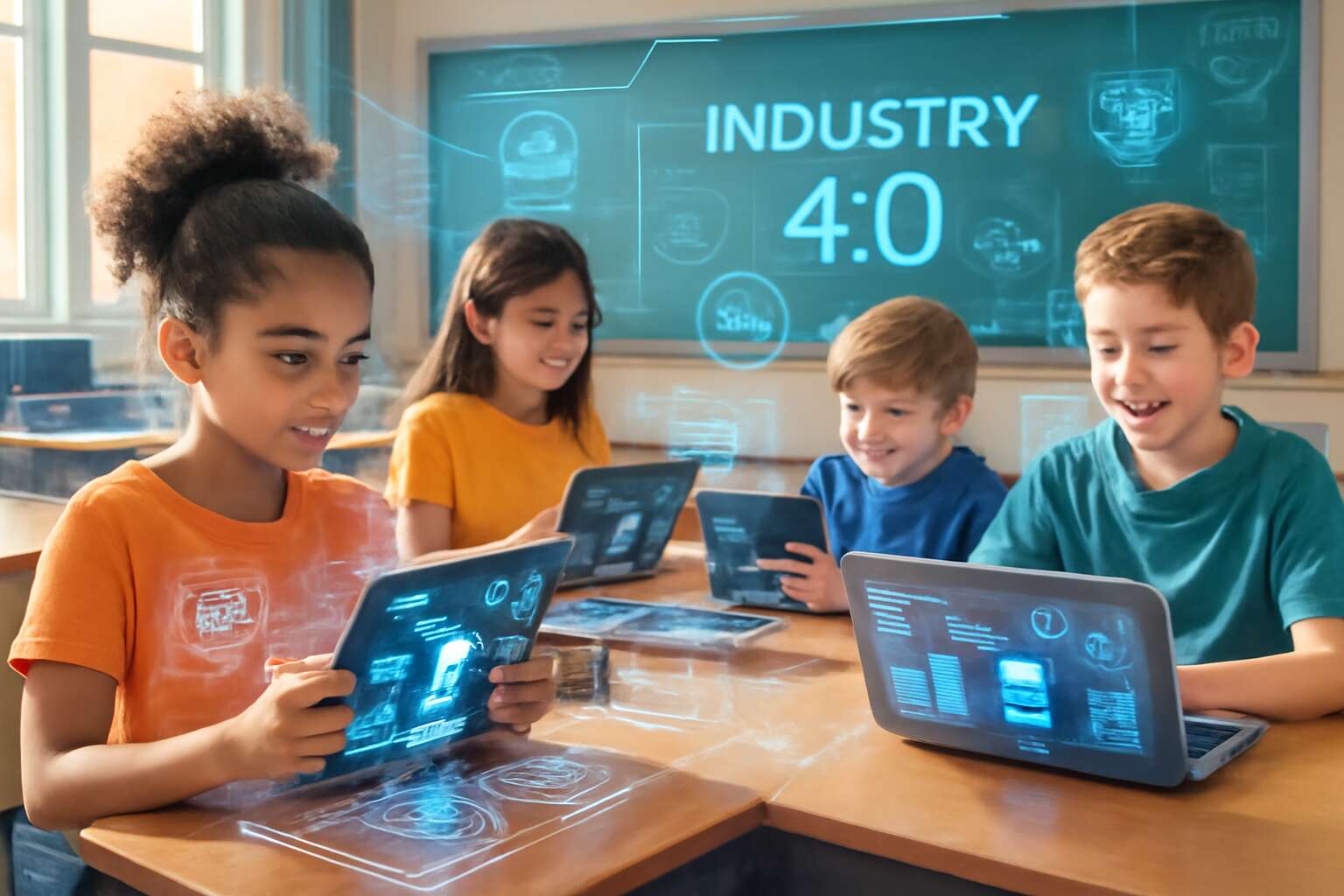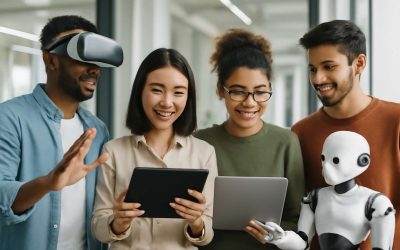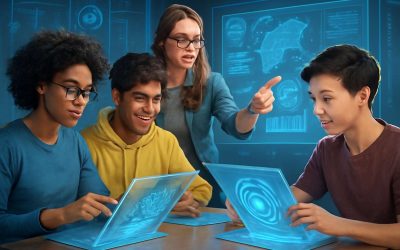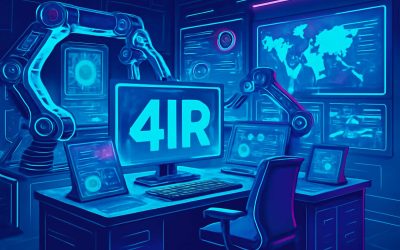Understanding the Fourth Industrial Revolution in Education
Definition of 4IR – Explaining the Fourth Industrial Revolution
The 4IR meaning in education is more than just a buzzword; it signals a profound transformation in how we perceive learning itself. As technologies like artificial intelligence, blockchain, and the Internet of Things become deeply embedded in our daily lives, the educational landscape is experiencing an unprecedented shift. This revolution is not merely about digitising classrooms but reimagining the very fabric of teaching and learning processes.
Understanding the Fourth Industrial Revolution in education means recognising a seismic shift towards personalised, data-driven, and immersive learning experiences. Unlike previous eras, where education was predominantly static, 4IR introduces adaptive systems that respond to individual student needs in real-time. This evolution demands new skills from educators and students alike, fostering an environment where innovation is the norm rather than the exception.
- Integration of virtual and augmented reality for immersive lessons
- Use of big data to tailor educational pathways
- Automation of administrative tasks to focus on core teaching
The 4IR meaning in education encapsulates a future where technology and pedagogy are seamlessly intertwined, opening doors to possibilities previously thought impossible. This ongoing revolution holds the key to unlocking a more inclusive, adaptable, and forward-thinking educational system.
Origins of 4IR in Education – Historical context and development
The roots of the 4IR meaning in education stretch back to a time when technological progress was primarily about mechanisation and automation. Over the past few decades, rapid advances in digital technology have reshaped how societies function and, inevitably, how we learn. The development of the internet, mobile devices, and cloud computing laid the groundwork for a more interconnected world—one where education could become more accessible and personalised.
Historically, educational systems were built around standardised curricula and fixed pedagogical methods. However, as the digital revolution accelerated, it became clear that these traditional approaches could no longer meet the demands of a rapidly changing job market. The 4IR meaning in education is rooted in this historical shift, recognising the need for more adaptable and innovative teaching models.
Key milestones in the development of 4IR in education include the integration of virtual learning environments and the use of data analytics to inform teaching strategies. These developments have paved the way for:
- personalised learning pathways
- automation of administrative tasks
- the rise of immersive technologies like virtual and augmented reality
Understanding the origins of the 4IR in education provides vital context for appreciating how far the sector has come—and where it is headed. It’s a story of continuous evolution driven by technological innovation and societal needs, ultimately shaping a future where education is more inclusive, flexible, and responsive than ever before.
Core Technologies Driving 4IR – Artificial intelligence, IoT, robotics, and more
At the heart of the 4IR meaning in education lies a symphony of core technologies that are transforming how knowledge is created, shared, and experienced. Artificial intelligence (AI), the keystone of this revolution, personalises learning journeys, adapting content to individual needs with uncanny precision. The Internet of Things (IoT) connects classrooms through a web of smart devices, fostering a seamless, interconnected environment where data flows effortlessly, enhancing both engagement and efficiency.
Robotics and automation further elevate the educational landscape, enabling interactive, immersive experiences that go beyond traditional boundaries. For instance, robotics can simulate real-world scenarios in science labs, making learning more tangible and captivating. These innovations are not merely tools but catalysts for a profound shift in pedagogical paradigms.
- AI-driven analytics inform educators about student progress in real-time, allowing for agile adjustments to teaching strategies.
- The integration of virtual and augmented reality creates immersive environments that stimulate curiosity and deepen understanding.
- IoT-enabled devices facilitate personalised feedback, fostering a more inclusive learning environment.
Understanding the 4ir meaning in education requires an appreciation of how these core technologies converge to craft a future where learning is more dynamic, accessible, and adaptable. It is a frontier where human ingenuity meets technological prowess, promising an educational renaissance unlike any before.
Key Features of 4IR in Educational Contexts
Digital Transformation of Learning – Online platforms, virtual classrooms
The 4ir meaning in education signifies a seismic shift—one that transforms traditional classrooms into dynamic hubs of innovation and interactivity. With digital transformation of learning accelerating at an unprecedented pace, online platforms and virtual classrooms have become the new normal. These technological advancements extend beyond mere convenience; they foster personalised learning experiences tailored to individual student needs, making education more accessible and inclusive.
This evolution is driven by core technologies such as artificial intelligence, augmented reality, and the Internet of Things, which seamlessly integrate into learning environments. The digital transformation of learning enables educators to utilise sophisticated tools like adaptive assessments and immersive simulations, enriching the educational journey. As a result, students are empowered to develop critical skills, preparing them for a rapidly changing world where the 4ir meaning in education is no longer optional but essential for future success.
Personalized and Adaptive Learning – AI-driven customization
The 4IR meaning in education is revolutionising how students learn and teachers teach. Personalised and adaptive learning are at the forefront of this transformation. Thanks to artificial intelligence (AI), educational content is now tailored to individual student needs, making learning more effective and engaging. No longer do students follow a one-size-fits-all approach; instead, they experience customised pathways that adapt in real-time to their progress.
AI-driven systems analyse performance data and modify lessons accordingly, ensuring each learner receives the right support at the right time. This dynamic approach fosters deeper understanding and retention. Moreover, the use of immersive technologies like augmented reality (AR) and virtual classrooms creates environments where students can explore complex concepts interactively.
- Real-time feedback helps students correct misconceptions instantly.
- Personalised assessments measure true understanding.
- Learning experiences are aligned with individual pace and style.
Ultimately, the 4ir meaning in education signifies a shift towards smarter, more inclusive learning ecosystems. By leveraging AI and other core technologies, education becomes more accessible, engaging, and relevant for the future workforce. This is not just evolution; it’s a revolution in how knowledge is acquired and applied.
Data-Driven Decision Making – Analytics and insights for educators and students
In the realm of 4IR meaning in education, data-driven decision making emerges as a cornerstone. It’s a process that transforms raw numbers into profound insights, shaping the future of learning environments. With the advent of sophisticated analytics, educators can now peer into the intricacies of student performance with unprecedented clarity. This isn’t just about tracking grades; it’s about understanding the nuances of learning behaviours, motivation, and engagement.
By harnessing real-time data, teachers can personalise interventions, ensuring that no student slips through the cracks. Students, in turn, benefit from tailored feedback that accelerates their mastery of complex concepts. This symbiosis of human intuition and machine intelligence fosters an ecosystem where educational strategies are continuously refined.
Some key features of data-driven decision making in 4IR meaning in education include:
- Advanced analytics tools that process vast amounts of performance data
- Visual dashboards providing instant insights for educators
- Predictive models that identify at-risk learners early
- customised learning pathways based on individual data profiles
Ultimately, this technological lens offers a new depth of understanding—one that challenges traditional assumptions and invites a more nuanced approach to education. It’s an era where insights are as vital as instruction itself, echoing the profound shift that 4IR meaning in education embodies. The fusion of data and human empathy paves the way for smarter, more inclusive learning ecosystems—where decisions are not just made but understood at their core.
Blended and Remote Learning Models – Hybrid educational approaches
In the shadowy corridors of modern learning, the 4IR meaning in education unfurls like a spectral tapestry—an unseen force transforming the very fabric of pedagogy. Blended and remote learning models stand at the heart of this revolution, offering a darkly enchanting fusion of physical presence and digital immersion. These hybrid approaches create an environment where students are no longer bound by brick walls but are instead beckoned into a boundless digital realm that morphs seamlessly with traditional classrooms.
What makes this shift so compelling is the intelligent orchestration behind it. Technology weaves together live lectures, virtual classrooms, and asynchronous resources into a cohesive experience. It’s as if the boundaries between reality and digital fantasy blur, allowing educators to craft personalised pathways for each learner. This convergence of physical and virtual spaces makes learning more inclusive, adaptable, and deeply immersive—hallmarks of the 4IR meaning in education.
Within this spectral symphony, the key features of 4IR in educational contexts include:
- Adaptive platforms that respond to student engagement in real-time
- Seamless integration of online and offline resources
- Intelligent scheduling tools that optimise learning flows
- Virtual labs and simulation environments that deepen understanding
As shadows lengthen and technology advances, the future of hybrid education beckons with an almost hypnotic allure—an intricate dance where human intuition and machine precision entwine, shaping a new dawn in 4IR meaning in education. It is a realm where the mysterious power of innovation whispers through every lesson, every interaction, casting an eternal glow on the path of knowledge.
Impact of 4IR on Educational Practices
Enhancing Student Engagement – Gamification, AR/VR applications
The 4IR meaning in education transcends traditional boundaries, transforming classrooms into immersive worlds of discovery. One of the most captivating impacts is the rise of gamification, turning learning into an adventure where students earn points, unlock levels, and solve challenges that mirror real-world problems. This approach ignites curiosity and fuels a love for learning that lasts well beyond the classroom walls.
Augmented Reality (AR) and Virtual Reality (VR) applications further revolutionise student engagement by creating sensory-rich environments that make abstract concepts tangible. Imagine exploring the human bloodstream or walking through historical landmarks—all within the safety of a digital space. These innovations foster active participation, making learning both memorable and meaningful.
- Interactive simulations
- Immersive storytelling
- Real-time feedback
Such technologies embody the essence of the 4IR meaning in education—blending digital innovation with pedagogical strategies to inspire young minds. As educators harness these tools, student engagement reaches new heights, sparking a generation prepared for an interconnected, technologically driven world.
Innovative Teaching Methods – Flipped classrooms, competency-based education
The 4IR meaning in education signifies a profound shift — a metamorphosis where traditional pedagogies give way to revolutionary teaching methods that captivate and inspire. As classrooms evolve into hubs of innovation, educators are embracing strategies like flipped classrooms and competency-based education, sculpting learning experiences that are both personalised and dynamic. These approaches foster mastery over skills and knowledge at each student’s own pace, transforming passive recipients into active architects of their learning journey.
With the advent of the 4IR, teaching becomes less about delivering content and more about igniting curiosity. Flipped classrooms, for instance, invert the traditional model, allowing students to explore new concepts at home and engage in hands-on activities during class time. This not only deepens understanding but also cultivates critical thinking and collaboration. Meanwhile, competency-based education aligns seamlessly with the digital age, emphasising mastery over time spent, and empowering learners to demonstrate their skills confidently.
- Personalised learning pathways driven by AI
- Real-time assessment tools that adapt to student progress
- Flexible curricula responsive to individual needs
Such innovations exemplify the essence of the 4IR meaning in education — an era where technology seamlessly intertwines with pedagogy to forge new horizons of possibility. The result? An educational landscape that nurtures not only knowledge but also resilience, adaptability, and lifelong curiosity in learners prepared for a future shaped by the Fourth Industrial Revolution.
Curriculum Modernization – Integrating 4IR skills and competencies
The 4IR meaning in education signifies a pivotal transformation that reshapes curricula, demanding a comprehensive modernisation to keep pace with technological advancements. As the Fourth Industrial Revolution continues to accelerate, educational institutions face the challenge of integrating new skills and competencies essential for tomorrow’s workforce. This isn’t just about adding digital tools; it’s about reimagining the very fabric of learning.
Curriculum modernisation driven by 4IR involves embedding core technologies—such as artificial intelligence, robotics, and IoT—into the learning environment. Schools and universities are adopting innovative approaches that foster critical thinking, problem-solving, and adaptability. For example, incorporating project-based learning that utilises digital simulations offers students practical experience aligned with current industry demands.
Furthermore, the 4ir meaning in education extends to the development of specialised programmes that prioritise digital literacy and technological fluency. Educational leaders are now crafting flexible, future-ready curricula that respond dynamically to the rapid evolution of technology. This ensures learners graduate with not only foundational knowledge but also the advanced skills crucial for thriving in a digital economy.
Ultimately, curriculum modernisation in the era of 4IR isn’t just a trend; it’s an imperative that prepares students to navigate and excel in a world where technological fluency is the new literacy. The integration of 4IR skills and competencies within educational practices is shaping a resilient, innovative, and adaptable generation ready to meet the challenges of the future head-on!
Benefits and Challenges of 4IR in Education
Advantages – Increased accessibility, efficiency, skill development
The transformative impact of the 4IR meaning in education is often celebrated for its remarkable benefits, yet it also presents a handful of challenges that cannot be ignored. One of the most notable advantages is increased accessibility; learners from remote corners of the globe can now access quality education through digital platforms, breaking geographical barriers that once seemed insurmountable. Additionally, efficiency in learning processes has skyrocketed with the integration of AI and automation, allowing students and educators to focus on what truly matters—deep understanding and critical thinking.
However, the road to seamless integration isn’t entirely smooth. Digital divides, infrastructural limitations, and concerns over data privacy pose significant hurdles. Despite these challenges, the 4ir meaning in education continues to evolve, driven by innovative teaching methods and curriculum modernisation that prioritise 21st-century skills. The synergy of these elements promises a future where education is not only more accessible but also more adaptable, preparing learners for a rapidly changing world.
Challenges – Digital divide, data privacy concerns, teacher training
While the 4IR meaning in education promises a transformative leap forward, it also introduces complex challenges that cannot be overlooked. One of the most pressing issues is the digital divide. In many rural and underserved communities, limited access to reliable internet and modern devices hampers the ability to fully benefit from 4IR-driven learning tools. This gap risks widening educational inequalities and leaving behind those who need it most.
Data privacy concerns also loom large. As educational institutions increasingly rely on digital platforms and data analytics, safeguarding sensitive student information becomes paramount. Without robust security measures, learners’ privacy could be compromised, eroding trust and safety within digital learning environments. Additionally, teachers face the daunting task of adapting to these rapid technological shifts. Effective teacher training for 4IR in education is essential but often insufficient, leaving many educators feeling unprepared to harness new tools fully.
To navigate these hurdles, innovative approaches like targeted infrastructure investment and comprehensive professional development are vital. Only then can the true potential of the 4ir meaning in education be realised, ensuring that technological progress uplifts all learners, regardless of their circumstances.
The Future of Education in the Era of 4IR
Emerging Trends – AI tutors, blockchain credentials, and more
As the digital tapestry of our world continues to evolve at an unprecedented pace, the 4IR meaning in education reveals a landscape where technological innovation no longer merely supports learning but fundamentally transforms its very fabric. The future of education in the era of 4IR is characterised by an intricate dance between artificial intelligence tutors, blockchain credentials, and immersive digital environments that challenge traditional pedagogical boundaries. AI tutors, for instance, are no longer distant fantasy but integral to personalised learning pathways, adapting in real-time to student needs and fostering a deeper engagement with complex concepts.
Blockchain credentials, meanwhile, promise a revolution in credentialing—creating tamper-proof digital records that are both portable and universally recognised. This confluence of emerging trends signifies more than just technological advancement; it embodies a shift towards decentralised, accessible, and more equitable education systems. As these innovations mature, the 4ir meaning in education becomes synonymous with a renaissance—where human potential is unlocked through the seamless integration of cutting-edge digital tools.
Policy and Infrastructure Needs – Supporting technological integration
The dawn of the 4IR meaning in education heralds a seismic shift in how knowledge is cultivated and disseminated. As technological infrastructure continues to evolve at an unprecedented velocity, the future of education demands robust policies and resilient infrastructure that can support this digital renaissance. Governments and institutions must invest in high-speed connectivity, advanced data security, and scalable digital platforms to foster seamless integration of emerging technologies. Without these foundational pillars, the transformative potential of 4IR in education risks being stifled by disparities and inefficiencies.
Supporting technological integration requires a strategic blueprint—one that balances innovation with inclusivity. Critical to this vision is developing policies that encourage equitable access, bridging the digital divide that still hampers many learners. Infrastructure must be agile, adaptable, and future-proof, accommodating innovations such as AI tutors, blockchain credentials, and immersive AR/VR environments. These digital tools do not merely enhance learning—they redefine the very essence of educational engagement, making it more dynamic, personalised, and accessible for all.
Preparing Educators and Students – Skills development for the 4IR era
As the dawn of the 4IR meaning in education unfolds, the landscape of learning transforms into a vibrant tapestry woven with innovation and human ingenuity. Preparing educators and students for this brave new world demands a renaissance of skills—an alchemy that turns traditional teaching into a symphony of digital mastery. The future belongs to those who can navigate this intricate web of technological marvels, embracing tools that enhance critical thinking, creativity, and adaptability.
To truly thrive in the era of 4IR, both educators and students must embark on a journey of continuous skills development. This entails cultivating digital literacy, fostering agility, and nurturing a mindset open to perpetual evolution. Schools and universities should focus on integrating skills such as data analysis, problem-solving with AI, and digital ethics—cornerstones of the 4IR meaning in education. These competencies ensure learners are not mere spectators but active architects of their own futures.
In this brave new epoch, success hinges on a balanced approach—where technological prowess coexists with human-centric values. An effective strategy might include:
- Embedding interdisciplinary learning that bridges science, technology, and the arts
- Implementing immersive environments like virtual and augmented reality to stimulate curiosity
- Encouraging collaborative projects that mirror real-world challenges
As the world pivots towards a future shaped by the Fourth Industrial Revolution, the real magic lies in cultivating adaptable, forward-thinking minds—ready to seize opportunities and confront challenges with resilience and ingenuity. The 4IR meaning in education is not merely a technological evolution but a profound transformation of how knowledge and skills are forged in the forge of progress.
Practical Examples of 4IR Applications in Education
Global Case Studies – Innovative schools and programs worldwide
Across the globe, innovative schools are embracing the 4IR meaning in education with gusto, transforming traditional classrooms into hubs of technological marvels. For instance, in Finland, some schools have integrated AI-driven tutors that adapt to each student’s learning pace, making the 4IR revolution tangible in everyday lessons. Meanwhile, in South Korea, virtual reality field trips transport students to ancient ruins or distant planets without leaving their desks—proof that the 4IR’s core technologies are revolutionising experiential learning.
In Canada, a pioneering program employs blockchain credentials to securely verify student achievements, simplifying the pathway from education to employment. These real-world applications demonstrate how the 4IR meaning in education extends beyond buzzwords—impacting curriculum design, student engagement, and skills development. The integration of IoT devices in classrooms allows teachers to monitor student participation in real time, creating a more personalised and data-driven learning environment.
Local Initiatives – Regional projects and success stories
Across regions, local initiatives are vividly illustrating the transformative power of the 4IR meaning in education. In rural communities, innovative projects harness mobile technology to bridge the digital divide, ensuring learners access quality resources regardless of their geographical location. For example, some regions deploy solar-powered devices loaded with educational content, allowing students to explore virtual laboratories and interactive lessons even in remote areas.
In urban centres, schools are embracing cutting-edge solutions such as IoT-enabled classrooms that adapt in real-time to student needs. An inspiring success story from northern England features a programme where data analytics monitor student engagement, enabling teachers to tailor instructions dynamically. This personalised approach exemplifies how the 4IR meaning in education extends beyond tech buzzwords to tangible improvements in learning outcomes.
- Implementation of virtual reality (VR) field trips that bring history and science to life, captivating students’ imaginations.
- Deployment of blockchain-based credentials that streamline certification and foster trust in skill verification.
These regional projects are more than isolated successes—they are microcosms of the broader revolution, where technology fuels inclusive, engaging, and future-ready education. The 4IR meaning in education truly manifests at the grassroots level, inspiring a new generation of learners prepared for a rapidly evolving world.




0 Comments